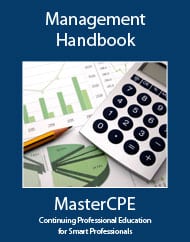Course Information
Management Handbook
Course Information
| Title: | Management Handbook |
|---|---|
| Category: | Business Management and Organization |
| Field of Study: | Business Management and Organization |
| Course Code: | M227 |
| CPE Credits: | 8.0 |
| Price: | 59.95 |
Description
Description:
This course teaches you the art and science of managing and accomplishing organizational goals and improving the way organizations are managed. Management refers to the process of coordinating and integrating work activities so that they are completed efficiently and effectively with and through other people. Managers of today need to be equipped with all the tools and concepts necessary to perform managerial activities in order to be globally competitive. Topics include functions of managers, strategies, planning, decision making, organization, leadership, motivation, control, total quality management (TQM), the role of technology, international business, and analysis of problems central to management.
Delivery Method: Online Interactive Self Study
Level: Overview
Prerequisites: None
Advanced Preparation: None
Course Details
Category: Business Management and Organization
Field of Study: Business Management and Organization
Passing Score: 70%
Technical Details: Business management and organization are non-technical subjects.
For More Detail:
If you are unable to view PDF then right click the mouse and click save link as
Objectives
Objectives:
Chapter 1: Management Introduction
- Recognize different systems used by management.
- Identify traits required by management in the 21st century vs. earlier periods.
- Differentiate among the five major managerial functions.
- Recognize the difference between group and individual decision-making process.
Chapter 2: Objectives and Planning
- Identify the characteristics of effective objectives.
- Recognize management by objectives (MBO).
- Recognize characteristics of formal vs. informal planning.
- Differentiate among the types of analysis used for managerial decisions.
- Differentiate between strategic planning versus tactical planning and the different levels of the organization involved.
- Recognize the key steps in planning.
Chapter 3: Organization
- Identify and differentiate horizontal and vertical organizations.
- Recognize approaches to departmentation and the benefits associated with departmentation.
- Differentiate between the use of power and authority to accomplish objectives.
- Recognize why managers are reluctant to delegate.
- Identify benefits of decentralized authority.
- Distinguish between line and staff authority.
Chapter 4: Organization Structures and Staffing
- Differentiate between line and staff organizations.
- Recognize the concept of a matrix organization.
- Identify factors common to all informal work groups.
- Identify some organization change and dynamics, and how the change and its impact on employees can be influenced by management
- Recognize the components of a good job description and the responsibility of human resources.
Chapter 5: Motivation and Leadership
- Recognize Maslow’s need hierarchy, Herzberg’s two-factor theory, and things that a manager can do to affect motivation.
- Identify the elements of good direction.
- Recognize different management theories and leadership skills.
Chapter 6: Communication and Developing Employees
- Differentiate among different types of communication.
- Recognize various methods of employee performance appraisal.
Chapter 7: Controls
- Recognize the concepts associated with controls.
- Identify different characteristics of quality control.
- Recognize different tools used for control.
Chapter 8: Other Management Topics
- Identify methods for implementing a Total Quality Management (TQM) program.
- Recognize the importance of politics and cultures in international management.
- Differentiate between different methods used to help analyze management decisions.
For More Objectives:
If you are unable to view PDF then right click the mouse and click save link as
Profession
NASBA: Yes
QAS: Yes
CPA: Suitable for all CPAs
IRS: No IRS credit for Enrolled Agents.
Profession Identifiers: CPA

